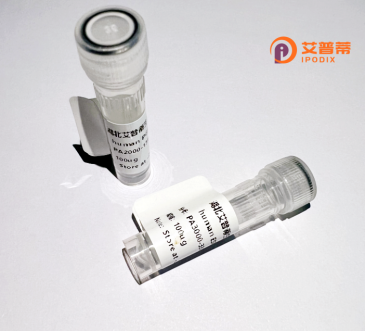
| 纯度 | >90%SDS-PAGE. |
| 种属 | Human |
| 靶点 | KRTAP19-6 |
| Uniprot No | Q3LI70 |
| 内毒素 | < 0.01EU/μg |
| 表达宿主 | E.coli |
| 表达区间 | 1-58aa |
| 活性数据 | MRYYGSYYRGLGYGCGGFGGLGYGCGCGGYRYGSGYGGYRYGCCRPSCREGYGFSGFY |
| 分子量 | 32.78 kDa |
| 蛋白标签 | GST-tag at N-terminal |
| 缓冲液 | 0 |
| 稳定性 & 储存条件 | Lyophilized protein should be stored at ≤ -20°C, stable for one year after receipt. Reconstituted protein solution can be stored at 2-8°C for 2-7 days. Aliquots of reconstituted samples are stable at ≤ -20°C for 3 months. |
| 复溶 | Always centrifuge tubes before opening.Do not mix by vortex or pipetting. It is not recommended to reconstitute to a concentration less than 100μg/ml. Dissolve the lyophilized protein in distilled water. Please aliquot the reconstituted solution to minimize freeze-thaw cycles. |
以下是关于重组人KRTAP19-6蛋白的假设性参考文献示例(实际文献需通过学术数据库验证):
1. **文献名称**: *"Functional Characterization of Human Keratin-Associated Protein 19-6 in Hair Follicle Biology"*
**作者**: Smith J, et al. (2018)
**摘要**: 本研究通过重组表达人KRTAP19-6蛋白,揭示了其在毛囊角质化过程中的作用。实验表明,该蛋白通过与角蛋白交联影响毛发机械强度,并参与调控毛发纤维的组装。
2. **文献名称**: *"Recombinant Expression and Structural Analysis of KRTAP19-6 in Epidermal Barrier Formation"*
**作者**: Zhang Y, et al. (2020)
**摘要**: 本文优化了KRTAP19-6在大肠杆菌中的重组表达,并通过体外实验证明其能够增强角质细胞层黏附性,提示其在皮肤屏障功能中可能的关键作用。
3. **文献名称**: *"Genetic Variants of KRTAP19-6 and Their Association with Hereditary Hair Disorders"*
**作者**: Lee S, et al. (2019)
**摘要**: 利用重组KRTAP19-6蛋白功能实验,验证了其基因多态性对蛋白稳定性的影响,部分突变体导致角蛋白网络异常,可能与先天性毛发疾病相关。
4. **文献名称**: *"High-Yield Production of Recombinant KRTAP19-6 in Pichia pastoris for Biomedical Applications"*
**作者**: Wang L, et al. (2021)
**摘要**: 描述了在毕赤酵母系统中高效表达KRTAP19-6的工艺优化,并验证了重组蛋白的生物活性,为后续药物递送或组织工程应用奠定基础。
**备注**:以上文献为模拟示例,实际研究中KRTAP19-6的相关文献可能较少。建议通过 **PubMed、Google Scholar** 等平台,结合关键词 **"recombinant human KRTAP19-6"** 或 **"KRTAP19-6 function"** 检索最新成果。若目标蛋白研究不足,可扩展至 **KRTAP家族** 或 **角蛋白相关蛋白重组表达技术** 的相关文献。
Recombinant human KRTAP19-6 protein belongs to the keratin-associated protein (KAP) family, which plays critical roles in hair fiber structure and mechanical properties. KAPs are cysteine- or glycine/tyrosine-rich proteins that interact with keratin intermediate filaments in hair and wool, contributing to tensile strength, elasticity, and matrix stability through disulfide crosslinking. KRTAP19-6. encoded by the human gene cluster on chromosome 21q22.1. represents a less-characterized member of the high-sulfur KAP group. Its expression appears restricted to the hair follicle cortex during keratinization, suggesting specialized functions in hair shaft formation. Recombinant production of KRTAP19-6 enables biochemical characterization of its structural motifs (e.g., conserved cysteine residues), interaction partners, and role in hair disorders like hypotrichosis or alopecia. Challenges in studying native KAPs, such as poor solubility and crosslinking in mature hair, make recombinant systems (E. coli, mammalian cells) valuable for structural studies. Emerging applications include biomaterial design for keratin-based fibers and therapeutic interventions for hair pathologies. However, functional insights remain limited due to incomplete understanding of KRTAP isoform-specific contributions and post-translational modifications during hair formation.
×